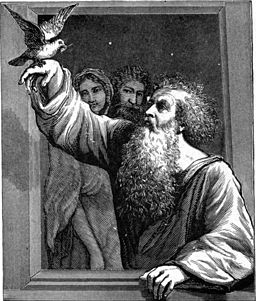Root Image
Lent Sunday 1 (B) (26 Feb 2012)
Homily of Fr. Paul Panaretos, S.J.
Certain images become controlling ones. They shape what comes to our minds. A red octagon suggests Stop even when we aren’t on the road. Scriptural images, too, shape what comes to our minds. Controlling images do not always aid our full appreciation. The name Noah often conjures the flood, which destroyed creation. While the flood may be more memorable, it fails to capture God’s heart and God’s desire for humans. Something Noah did offers us a more useful image.
After the deluge Noah released a dove from the ark. When it returned Noah knew waters still covered the earth. Later, when he released it, it returned with an olive branch: waters were receding. Finally, the dove did not return. It could build its nest, and Noah and his family went forth to build their homes.1
The climax of the Genesis account of Noah and his family is not destruction or devastation but life. God’s desire for life for all people is as broad as creation. God established this new life by covenant at God’s initiative. The name Noah and the word dove share the same Hebrew root. Noah sent the dove to learn if earth had surface. God sent forth Noah to live God’s covenant of life and to live it.
The dove was Noah’s indicator to leave the ark and enter the covenant God offered. You and I are God’s indicators: the way we live God’s covenant and embody God’s desire for all to thrive, not merely to survive, allow us to recall God’s desire for humans and help others to find refuge in it and make it appealing to live it, too. We were baptized for that.
The First Letter of Peter, a homily about Christian baptism, saw God’s promised life after the waters of the destroying flood fulfilled in the life of the Spirit in the water of dying with Jesus. It saw the Church protecting people as the ark protected Noah and his family.
Because the liturgy does not offer us the First Letter of Peter as often as the Letters of Paul, art and legend suggest the images of Noah and the flood are destructive. Read together Genesis and the First Letter of Peter help us know God’s desire is to preserve life, and more, to transform life from human to divine. As a dove indicated to Noah it was time to dwell again on the earth, how you and I live our baptisms indicates God abides with the world through us in Jesus by their Spirit.
Being the presence of our risen Messiah for others is challenging, especially in our culture. Some of its messages and values are indifferent, at best, even hostile to Genesis and the gospel. Mark’s Good News made another, more subtle Genesis-connection. Mark did not enumerate temptations of Jesus as did Matthew and Luke, who gave us our controlling images of Jesus in the desert. Instead, the First Gospel noted that Jesus was among wild beasts. How different the world had become because of sin: in God’s original creation no enmity existed between humans and animals! We are to live God’s covenant not by force but by example, even persuasive, graceful cunning. Jesus’ words echo Noah and our vocation as God’s indicators: Be shrewd as serpents and simple as doves.2
Though forces inimical both to God and to the gospel may beset us, God ministers to us, to protect us just as God ministered and protected God’s Son. Though to human eyes God seemed to have abandoned Jesus in death, God raised Jesus to absolutely new and indestructible life, the life of heaven as scripture names it. It is not merely to have faith; it is taking refuge in the covenant instead of cultural forces inimical to it.
That is the good news, gospel, to which Jesus calls us to enter and put on daily. Lent renews us in his good news. Entering it allows us to become more like Jesus, the new Noah, who waited patiently, confident God would save him; and not only save him but make fruitful his proclamation of the good news of salvation.
What then might Lent’s controlling image be for us this year as we enter it? We heard St. Paul offer a refreshing and restorative one Ash Wednesday: now is a very acceptable time…now is the day of salvation.3 Each day is now. Each moment is now. Each moment God invites us to live God’s life. Each moment God invites us to indicate and share by what we do the life God gives us. Each moment God invites us to allow the paschal mystery of the death and resurrection of our Messiah Jesus to transform us and renew us as courageous disciples.
In your 15 minutes with Jesus this week
- Compose yourself in the life-giving love of the Trinity.
- Ask your patron saint to present you to Jesus so you may converse with him.
- Speak to Jesus about the many images which seek to control your allegiance to him and to the risen life Jesus shares with you.
- Resolve to focus on your baptism and its life, dignity and vocation so you may renew the way you live your Christian life.
- Close saying slowly the Lord’s Prayer. No better prayer so succinctly appeals to God and helps us to live as agents of the new creation in Jesus, our risen Lord.
Link to this Sunday’s Spiritual Exercise
______________
- Genesis 8.8-12.
- Matthew 10.16.
- 2Corinthians 6.2, which closed the Second Reading at mass that day.
___________________________________________________________________
Wiki-image of Noah sending the dove is in the public domain in the U.S. Wiki-image of Jesus in the desert is in the public domain.


No comments:
Post a Comment